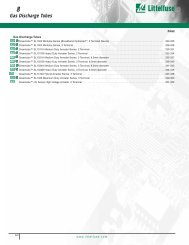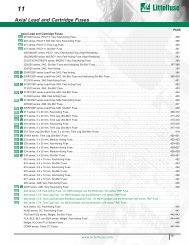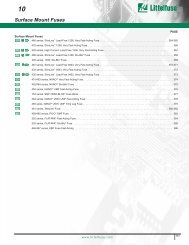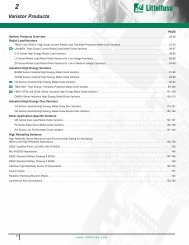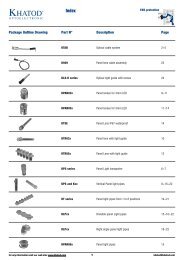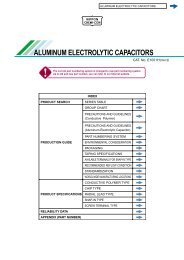TVS Diode Arrays
TVS Diode Arrays
TVS Diode Arrays
You also want an ePaper? Increase the reach of your titles
YUMPU automatically turns print PDFs into web optimized ePapers that Google loves.
<strong>TVS</strong> <strong>Diode</strong> <strong>Arrays</strong><br />
Electronic Protection Array for ESD and Overvoltage Protection<br />
SP723<br />
Absolute Maximum Ratings<br />
Continuous Supply Voltage, (V+) - (V-). ........................+35V<br />
Forward Peak Current, I IN to V CC , I IN to GND<br />
(Refer to Figure 6). .................................±4A, 100µs<br />
Peak Pulse Current, 8/20µs...................................±7A<br />
ESD Ratings and Capability (Figure 1, Table 1)<br />
Load Dump and Reverse Battery (Note 2)<br />
CAUTION: Stresses above those listed in “Absolute Maximum Ratings” may cause permanent damage to the device. This is a stress only rating and operation of the device<br />
at these or any other conditions above those indicated in the operational sections of this specification is not implied.<br />
NOTE:<br />
1. θJA is measured with the component mounted on an evaluation PC board in free air.<br />
Electrical Specification T A =40 o C to 105 o C, V IN = 0.5V CC , Unless Otherwise Specified<br />
ESD Capability<br />
ESD capability is dependent on the application and defined test<br />
standard.The evaluation results for various test standards and methods<br />
based on Figure 1 are shown in Table 1.<br />
The SP723 has a Level 4 HBM capability when tested as a device to the<br />
IEC 61000-4-2 standard. Level 4 specifies a required capability greater<br />
than 8kV for direct discharge and greater than 15kV for air discharge.<br />
For the “Modified” MIL-STD-3015.7 condition that is defined as an “incircuit”<br />
method of ESD testing, the V+ and V- pins have a return path to<br />
ground and the SP723 ESD capability is typically greater than 25kV from<br />
100pF through 1.5kΩ. By strict definition of MIL-STD-3015.7 using “pinto-pin”<br />
device testing, the ESD voltage capability is greater than 10kV.<br />
For the SP723 EIAJ IC121 Machine Model (MM) standard, the ESD capability<br />
is typically greater than 2kV from 200pF with no series resistance.<br />
www.littelfuse.com<br />
Thermal Information<br />
Thermal Resistance (Typical, Note 1) θJA ( oC/W) PDIP Package . ...........................................160<br />
SOIC Package . ..........................................170<br />
Storage Temperature Range . ...........................-65oC to 150oC Maximum Junction Temperature..............................150oC Lead Temperature (Soldering 10s). ........................... 300oC (SOIC - Lead Tips Only)<br />
STANDARD TYPE/MODE R D C D ±V D<br />
IEC 1000-4-2<br />
(Level 4)<br />
HBM, Air Discharge 330Ω 150pF 15kV<br />
HBM, Direct Discharge 330Ω 150pF 8kV<br />
MIL-STD-3015.7 Modified HBM 1.5kΩ 100pF 25kV<br />
Standard HBM 1.5kΩ 100pF 10kV<br />
EIAJ IC121 Machine Model 0kΩ 200pF 2kV<br />
H.V.<br />
SUPPLY<br />
°±V D<br />
TABLE 1. ESD TEST CONDITIONS<br />
CHARGE<br />
SWITCH<br />
R 1<br />
C D<br />
R D<br />
IEC 1000-4-2: R1 50 to 100MΩ<br />
MIL-STD-3015.7: R1 1 to 10MΩ<br />
DISCHARGE<br />
SWITCH<br />
IN<br />
DUT<br />
FIGURE 1. ELECTROSTATIC DISCHARGE TEST<br />
241<br />
5<br />
<strong>TVS</strong> DIODE ARRAYS





